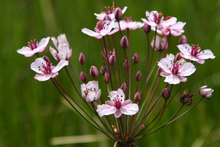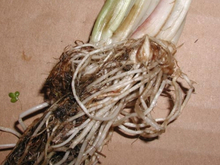Quick facts
Flowering rush is a prohibited invasive species. It is illegal to possess, import, purchase, transport, or introduce these species (including hybrids or cultivars) except under a permit or statutory exemption. Transport directly to the Minnesota Department of Natural Resources in a sealed container for identification or reporting purposes is permitted.
- Flowering rush can produce dense monotypic stands.
- May displace native species and interfere with boat traffic.
- Flowering rush should be reported.
See the Minnesota Department of Natural Resources recommendations for reporting invasive species.
How to identify flowering rush
- Flowering rush (Butomus umbellatus) is a perennial aquatic herbaceous plant that grows up to six feet tall along shores in shallow water.
- Can grow submerged in waters up to ten feet without producing flowers.
- When not in flower, it looks like common native shoreland plants and may be difficult to identify.
Stem
- Triangular in cross-section, may be more rounded toward the base.
Leaves
- Sword shaped, triangular in cross section, often twist near top.
Flowers
- Pink flowers are arranged in umbrella shaped clusters (umbels).
- Blooms late June to August.
Seeds
- Populations in the eastern U.S. produce seeds.
- Only one Minnesota population (Forest Lake) is known to produce viable seeds.
Roots
- Reproduces by vegetative spread from its rootstock in the form of bulbils.
- Both seeds and bulbils are dispersed by water current.
Reviewed in 2019




